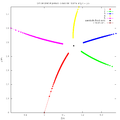Fractals/Iterations in the complex plane/petal
Petal of the Leau-Fatou flower
definition of the petal
[edit | edit source]
"The petals ... are interesting not only because they give a rather good intuitive idea of the dynamics that arise near a parabolic point, but also because that the dynamic of f0 on a petal can be linearized, i.e., it is conjugated to the shift map T of C defined by T(w) := w + 1." (Laurea Triennale[1])
- There is no unified definition of petals
- "The petals are Jordan domains invariant by " R PEREZ-MARCO[2] (where q is a child period. and parabolic c parameter is a root point between parent and child component of Mandelbrot set)
- Petal is trap which captures any orbit tending to parabolic point
- petal is a part of the flower
Petal of a flower can be:
- attracting / repelling
- small/alfa/big/ (small attracting petals do not ovelap with repelling petals, but big do)
Each petal is invariant under f^period. In other words it is mapped to itself by f^period.
Attracting petal P is a:
- Each petal is invariant under . In other words it is mapped to itself by :
- domain (topological disc) containing:
- parabolic periodic point p in its boundary (precisely in its root, which is a common points of all attracting and repelling petals = center of the Lea-Fatou flower)
- critical point or it's n=period images on the other side (only small ??)
- trap which captures any orbit tending to parabolic point[3]
- set contained inside component of filled-in Julia set. The attracting petals of parabolic fixed point are contained in it's basin of attraction
- " ... is maximal with respect to this property. This preferred petal P max always has one or more critical points on its boundary."[4]
- "an attracting petal is the interior of an analytic curve which lies entirely in the Fatou set, has the right tangency property at the fixed point, and is mapped into its interior by the correct power of the map" Scott Sutherland
- "... an attracting petal is a set of points in a sufficient small disk around the periodic point whose forward orbits always remain in the disk under powers of return map." (W P Thurston: On the geometry and dynamics of Iterated rational maps)
Petals are symmetric with respect to the d-1 directions:
where:
- d is (to do)
- l is from 0 to d-2
Petals can have different size.
If then Julia set should approach parabolic periodic point in n directions, between n petals.[5]
"Using the language of holomorphic dynamics, people would say that you are studying the dynamics of a polynomial near the parabolic fixed point . By a simple linear change of variables, the study of any such parabolic fixed point can be reduced to the study of . Then you can apply another change . Thus you are reduced to the study of . If the real part $Re(w)$ is large enough you will obtain . This will give you what you want (when going back to the z-variable).
The domain (for large ) looks like some kind of cardioid (in your particular case) when you visualize it in the z-variable (it's poetically called an attracting petal)." Sylvain Bonnot[6]
Constructing the petal
[edit | edit source]
Trap parameters:
- shape
- center
- size
How to choose size of attracting trap such that level curves cross at critical point ?
Target set for the components for child period:
- 1 and 2 target set can be circle with parabolic fixed point on it's boundary ( target set is inside component )
- for period 3 and higher ( p > 2) target set is a triangle fragment of the circle with center at parabolic fixed point.
- target set for components by period
-
p=1 circle
-
p=2 circle
-
p>2. triangle. Here target set is narrow so udefined points are visible
-
Rays and critical orbit for p = 11
Nota that trap for components is bigger then trap for BDM
- trap for componets : triangle
- trap for BDM : triangle
where
- z1, z2 are the last point of external rays bounding component ( usually the biggest one, with critical point inside )
- is the critical point, or it's forward image in case thet critical orbit arm is not straight line
- is parabolic fixed point
- is a precritical point = preimages of critical point
Because of lazy dynamics one stops the computation before critical orbit and external rays land on the parabolic fixed point. The remaining gap is filled (approximated) with line from the last point to the landing point.
-
computed and approximated parts
0/1 or 1/1
[edit | edit source]-
It is a dynamic plane for fc(z)=z^2 + 1/4. It is zoom around parabolic fixed point z=0.5. Orbits of some points inside Julia set are shown (white points).
-
Attracting petals (gray)
-
Dynamics near parabolic fixed point
-
Contunuus model of dynamics inside a 1 petals flower (dipol)
First attracting petal is a circle with:
- center on the x axis
- radius = (cabs(zf) + cabs(z))/2
Other (bigger) attracting petals are preimages of first petal which include first petal.
where:
- z is the last point of critical orbit.
- zf is a fixed point.
1/2
[edit | edit source]-
Model of dynamics inside a 2 petals flower (quadrupole)
-
Contour plot of the equipotential surfaces of an electric quadrupole field of a point-like quadrupole
circular attracting petal:
- center is between fixed point and critical point.
- radius smaller than half of the distance between fixed and critical point.
// choose such value that level sets cross at z=0
// choose radius such a
double GivePetalRadius(complex double c, complex double fixed, int n){
complex double z = 0.0; // critical point
int k;
// best for n>1
int kMax = (n*ChildPeriod) - 1; // ????
for(k=0; k<kMax-1; ++k)
z = z*z + c; // forward iteration
return cabs(z-fixed)/2.0;
}
1/3
[edit | edit source]-
Orbits near fixed point of fat Douady rabbit Julia set
Method by Scott Sutherland:[7]
- choose the connected component containing the critical point
- find an analytic curve which lies entirely in the Fatou set, has the right tangency property at the fixed point, and is mapped into its interior by the correct power of the map
- the other two are just the image of this curve under the first and second iterates.
other cases
[edit | edit source]-
1/30
Number of petals
[edit | edit source]| This page was last edited 24 months ago, and may be abandoned This page has not been edited since 18 March 2023, but other pages in this book might have been. Check out related changes to see what the state of this book is. You can help by editing and updating this book. Remove {{under construction}} from this page if it is not being actively edited. Ask for help at WB:PROJECTS. |

For quadratic polynomials:
Multiplicity = ParentPeriod + ChildPeriod
NumberOfPetals = multiplicity - ParentPeriod
It is because in parabolic case fixed point coincidence with periodic cycle. Length of cycle (child period) is equal to number of petals.
-
One critical point and 5 petals
-
13 critical points and 26 petals.
-
14 critical points and 14 petals.
-
z^4-z has 3 critical points and 6 petals
| f(z) | number of petals | explanation |
|---|---|---|
| d-1 | for point z=0 has multiplicity d | |
| d+2 | (?)for a root z=0 has multiplicity d+3 | |
For f(z)= -z+z^(p+1) parabolic flower has:
- 2p petals for p odd
- p petals for p even[8]
... (to do)
References
[edit | edit source]- ↑ The Hausdorff dimension of the boundary of the Mandelbrot set. Tesi di Laurea Triennale
- ↑ Ricardo Pérez-Marco. "Fixed points and circle maps." Acta Math. 179 (2) 243 - 294, 1997. https://doi.org/10.1007/BF02392745
- ↑ PARABOLIC IMPLOSION A MINI-COURSE by ARNAUD CHERITAT
- ↑ A FAMILY OF DEGREE 4 BLASCHKE PRODUCTS by Jordi Canela
- ↑ BOF, page 39
- ↑ Asymptotics of iterated polynomials
- ↑ An Introduction to Julia and Fatou Sets by Scott Sutherland ( January 2014 DOI10.1007/978-3-319-08105-2__3 )
- ↑ A Lösungen zu den Übungenn by Michael Becker













































